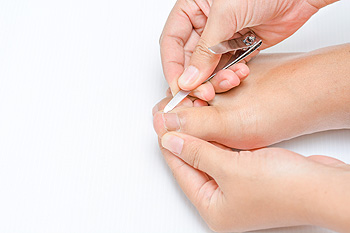
An ingrown toenail is often difficult to ignore. It is easy to notice, as the nail grows into the skin instead of over it. The symptoms include severe pain where the nail meets the skin, and it is often red and swollen. Shoes may be painful to wear, and relief is often sought. A temporary remedy consists of soaking the affected foot in warm water, and this can help to soften the skin. At this point, a small piece of cotton can be used to gently pull the skin away from the nail. The pain can return once the skin has hardened, and it is advised to seek professional medical attention which can help to provide a permanent solution. A common reason why ingrown toenails develop can be from the shoes that are worn, which may be too tight. Additionally, it may happen from trimming the toenails incorrectly, possibly causing the nail to cut into the skin. If you have developed this painful foot condition, it is strongly suggested that you confer with a podiatrist who can provide effective treatment methods and relieve painful symptoms.
Ingrown toenails can become painful if they are not treated properly. For more information about ingrown toenails, contact Dr. Lubrina Bryant of District Podiatry, PLLC. Our doctor can provide the care you need to keep you pain-free and on your feet.
Ingrown Toenails
Ingrown toenails occur when a toenail grows sideways into the bed of the nail, causing pain, swelling, and possibly infection.
Causes
Prevention
Because ingrown toenails are not something found outside of shoe-wearing cultures, going barefoot as often as possible will decrease the likeliness of developing ingrown toenails. Wearing proper fitting shoes and using proper cutting techniques will also help decrease your risk of developing ingrown toenails.
Treatment
Ingrown toenails are a very treatable foot condition. In minor cases, soaking the affected area in salt or antibacterial soaps will not only help with the ingrown nail itself, but also help prevent any infections from occurring. In more severe cases, surgery is an option. In either case, speaking to your podiatrist about this condition will help you get a better understanding of specific treatment options that are right for you.
If you have any questions please feel free to contact our office located in Washington, D.C . We offer the newest diagnostic and treatment technologies for all your foot and ankle needs.